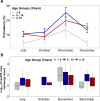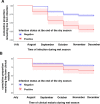Asymptomatic Plasmodium falciparum carriage at the end of the dry season is associated with subsequent infection and clinical malaria in Eastern Gambia
- PMID: 38229097
- PMCID: PMC10792942
- DOI: 10.1186/s12936-024-04836-y
Asymptomatic Plasmodium falciparum carriage at the end of the dry season is associated with subsequent infection and clinical malaria in Eastern Gambia
Abstract
Background: Chronic carriage of asymptomatic low-density Plasmodium falciparum parasitaemia in the dry season may support maintenance of acquired immunity that protects against clinical malaria. However, the relationship between chronic low-density infections and subsequent risk of clinical malaria episodes remains unclear.
Methods: In a 2-years study (December 2014 to December 2016) in eastern Gambia, nine cross-sectional surveys using molecular parasite detection were performed in the dry and wet season. During the 2016 malaria transmission season, passive case detection identified episodes of clinical malaria.
Results: Among the 5256 samples collected, 444 (8.4%) were positive for P. falciparum. A multivariate model identified village of residence, male sex, age ≥ 5 years old, anaemia, and fever as independent factors associated with P. falciparum parasite carriage. Infections did not cluster over time within the same households or recurred among neighbouring households. Asymptomatic parasite carriage at the end of dry season was associated with a higher risk of infection (Hazard Ratio, HR = 3.0, p < 0.0001) and clinical malaria (HR = 1.561, p = 0.057) during the following transmission season. Age and village of residence were additional predictors of infection and clinical malaria during the transmission season.
Conclusion: Chronic parasite carriage during the dry season is associated with an increased risk of malaria infection and clinical malaria. It is unclear whether this is due to environmental exposure or to other factors.
Keywords: Asymptomatic; Clinical malaria; Plasmodium falciparum; Seasonal transmission.
© 2024. The Author(s).
Conflict of interest statement
No conflicts of interest were reported by the authors.
Figures




Similar articles
-
Household clustering and seasonal genetic variation of Plasmodium falciparum at the community-level in The Gambia.Elife. 2025 May 27;13:RP103047. doi: 10.7554/eLife.103047. Elife. 2025. PMID: 40424190 Free PMC article.
-
Asymptomatic Plasmodium falciparum carriage and clinical disease: a 5-year community-based longitudinal study in The Gambia.Malar J. 2023 Mar 7;22(1):82. doi: 10.1186/s12936-023-04519-0. Malar J. 2023. PMID: 36882754 Free PMC article.
-
A Cohort Study on the Duration of Plasmodium falciparum Infections During the Dry Season in The Gambia.J Infect Dis. 2022 Aug 12;226(1):128-137. doi: 10.1093/infdis/jiac116. J Infect Dis. 2022. PMID: 35380684 Free PMC article.
-
The role of asymptomatic P. falciparum parasitaemia in the evolution of antimalarial drug resistance in areas of seasonal transmission.Drug Resist Updat. 2013 Feb-Apr;16(1-2):1-9. doi: 10.1016/j.drup.2013.02.001. Epub 2013 Mar 17. Drug Resist Updat. 2013. PMID: 23510592 Review.
-
Asymptomatic Low-Density Plasmodium falciparum Infections: Parasites Under the Host's Immune Radar?J Infect Dis. 2024 Jun 14;229(6):1913-1918. doi: 10.1093/infdis/jiad581. J Infect Dis. 2024. PMID: 38349649 Free PMC article. Review.
Cited by
-
Prevalence of asymptomatic malaria in high- and low-transmission areas of Tanzania: The role of asymptomatic carriers in malaria persistence and the need for targeted surveillance and control efforts.Parasites Hosts Dis. 2025 Feb;63(1):57-65. doi: 10.3347/PHD.24077. Epub 2025 Feb 25. Parasites Hosts Dis. 2025. PMID: 40045681 Free PMC article.
-
RNA polymerase III is involved in regulating Plasmodium falciparum virulence.Elife. 2024 Jun 26;13:RP95879. doi: 10.7554/eLife.95879. Elife. 2024. PMID: 38921824 Free PMC article.
-
Household clustering and seasonal genetic variation of Plasmodium falciparum at the community-level in The Gambia.Elife. 2025 May 27;13:RP103047. doi: 10.7554/eLife.103047. Elife. 2025. PMID: 40424190 Free PMC article.
-
scRNA-seq reveals transcriptional plasticity of var gene expression in Plasmodium falciparum for host immune avoidance.Nat Microbiol. 2025 Jun;10(6):1417-1430. doi: 10.1038/s41564-025-02008-5. Epub 2025 May 16. Nat Microbiol. 2025. PMID: 40379932
-
Multiplication rate variation of malaria parasites from hospital cases and community infections.Sci Rep. 2025 Jan 3;15(1):666. doi: 10.1038/s41598-024-82916-4. Sci Rep. 2025. PMID: 39753639 Free PMC article.
References
-
- WHO . World malaria report 2022. Geneva: World Health Organization; 2022.
-
- WHO . World malaria report 2021. Geneva: World Health Organization; 2021.
-
- Andolina C, Rek JC, Briggs J, Okoth J, Musiime A, Ramjith J, et al. Sources of persistent malaria transmission in a setting with effective malaria control in eastern Uganda: a longitudinal, observational cohort study. Lancet Infect Dis. 2021;21:1568–1578. doi: 10.1016/S1473-3099(21)00072-4. - DOI - PMC - PubMed
MeSH terms
Grants and funding
LinkOut - more resources
Full Text Sources
Medical

